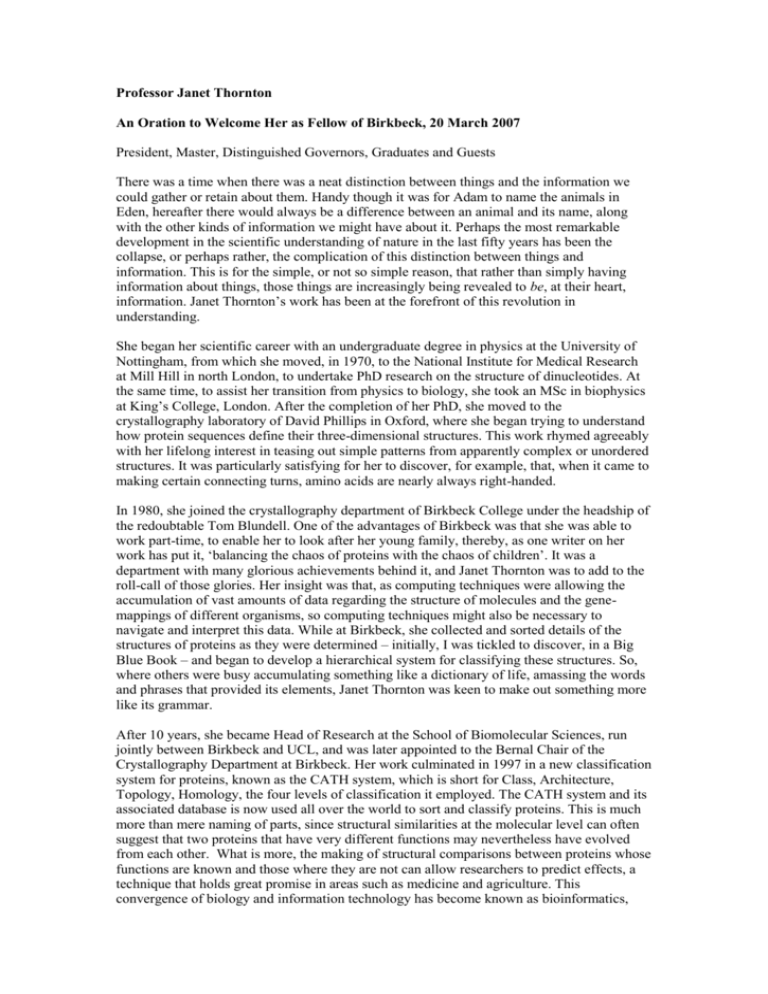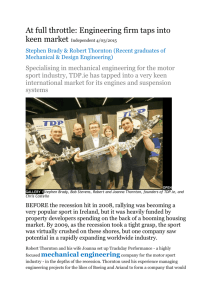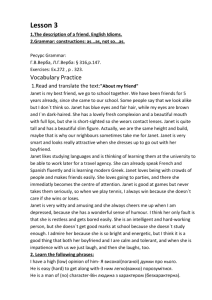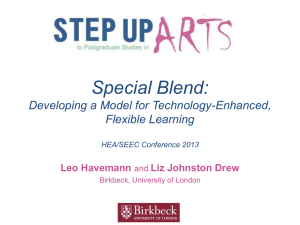There was a time when there was a distinction
advertisement

Professor Janet Thornton An Oration to Welcome Her as Fellow of Birkbeck, 20 March 2007 President, Master, Distinguished Governors, Graduates and Guests There was a time when there was a neat distinction between things and the information we could gather or retain about them. Handy though it was for Adam to name the animals in Eden, hereafter there would always be a difference between an animal and its name, along with the other kinds of information we might have about it. Perhaps the most remarkable development in the scientific understanding of nature in the last fifty years has been the collapse, or perhaps rather, the complication of this distinction between things and information. This is for the simple, or not so simple reason, that rather than simply having information about things, those things are increasingly being revealed to be, at their heart, information. Janet Thornton’s work has been at the forefront of this revolution in understanding. She began her scientific career with an undergraduate degree in physics at the University of Nottingham, from which she moved, in 1970, to the National Institute for Medical Research at Mill Hill in north London, to undertake PhD research on the structure of dinucleotides. At the same time, to assist her transition from physics to biology, she took an MSc in biophysics at King’s College, London. After the completion of her PhD, she moved to the crystallography laboratory of David Phillips in Oxford, where she began trying to understand how protein sequences define their three-dimensional structures. This work rhymed agreeably with her lifelong interest in teasing out simple patterns from apparently complex or unordered structures. It was particularly satisfying for her to discover, for example, that, when it came to making certain connecting turns, amino acids are nearly always right-handed. In 1980, she joined the crystallography department of Birkbeck College under the headship of the redoubtable Tom Blundell. One of the advantages of Birkbeck was that she was able to work part-time, to enable her to look after her young family, thereby, as one writer on her work has put it, ‘balancing the chaos of proteins with the chaos of children’. It was a department with many glorious achievements behind it, and Janet Thornton was to add to the roll-call of those glories. Her insight was that, as computing techniques were allowing the accumulation of vast amounts of data regarding the structure of molecules and the genemappings of different organisms, so computing techniques might also be necessary to navigate and interpret this data. While at Birkbeck, she collected and sorted details of the structures of proteins as they were determined – initially, I was tickled to discover, in a Big Blue Book – and began to develop a hierarchical system for classifying these structures. So, where others were busy accumulating something like a dictionary of life, amassing the words and phrases that provided its elements, Janet Thornton was keen to make out something more like its grammar. After 10 years, she became Head of Research at the School of Biomolecular Sciences, run jointly between Birkbeck and UCL, and was later appointed to the Bernal Chair of the Crystallography Department at Birkbeck. Her work culminated in 1997 in a new classification system for proteins, known as the CATH system, which is short for Class, Architecture, Topology, Homology, the four levels of classification it employed. The CATH system and its associated database is now used all over the world to sort and classify proteins. This is much more than mere naming of parts, since structural similarities at the molecular level can often suggest that two proteins that have very different functions may nevertheless have evolved from each other. What is more, the making of structural comparisons between proteins whose functions are known and those where they are not can allow researchers to predict effects, a technique that holds great promise in areas such as medicine and agriculture. This convergence of biology and information technology has become known as bioinformatics, 2 and Janet Thornton has played a decisive, indeed and indispensable role in its development. Indeed, one of her colleagues has said that ‘Janet Thornton could be described as Miss Structural Bioinformatics’, an epithet that, when compared with ‘The Queen of Sheba’ or ‘The Lady of the Lamp’, perhaps lacks a certain snappiness, but nevertheless reflects her foundational role in this vital area of science. In 1992, Thornton’s group devised a method known as protein threading, which predicted a protein’s structure from its sequence by threading that sequence onto a framework of existing protein folds and finding the neatest and most energy-efficient fit. You could perhaps think of putting a sock on to a darning egg, or stringing a tennis racket. In 1998, realising the possible value of their protein-modelling programmes for pharmaceutical research, she and her colleagues set up a highly successful company called Inpharmatica (a name that is as elegantly full of implication as one of her protein folds). She retained a long association with the company as scientific advisor. In 2001, Janet Thornton became director of the European Bioinformatics Institute in Cambridge. The aim of the EBI is to provide a way for researchers to navigate through the prodigious amounts of data on protein structure, DNA sequences and whole genome maps that are being produced in different areas of biological research, collecting, storing and managing the data in ways that allow it to be efficiently searched and retrieved. Under Janet Thornton’s leadership, the Institute has dramatically expanded its research activities, while continuing to keep its chin, and those of its users, above the flood of new data. More recently, she has been the scientific coordinator of Biosapiens, a European Virtual Institute for Genome Annotation. The aim of the Biosapiens network, which was set up in 2004 with 12 million euros from the EU, is to annotate genome data produced from bioinformatics researchers from 25 institutions based in 14 countries throughout Europe. The network will help improve the interpretation and exploitation of biological information, and can be expected to have important effects in the areas of drug development, health care, ageing and the understanding of diet. She has been the recipient of a string of awards and honours, with which, always keen to emphasise the achievements of her students and associates rather than her own, she would not wish me to weary you. In 1999, she was made a Fellow of the Royal Society. In 2000, she was awarded a CBE for services to structural biology. In 2002, she was appointed Extraordinary Fellow, Churchill College, Cambridge and Honorary Professor, University of Cambridge, and in 2003 she was elected a Foreign Associate Member of the American National Academy of Sciences in the United States. The philosopher of science Michel Serres proposes that the history of scientific enquiry can be divided into three great epochs. The first, extending from the earliest enquiries into the physical world conducted by Greek philosophers in the seventh century BC, was driven by the desire to ascertain the fixed and enduring forms of things. The second, beginning with the industrial revolution of the late eighteenth century, concerned itself less with forms than with transformations, of energy, mass, heat and light. The third epoch, which has begun perhaps only in living memory, is the epoch of information, in which living matter is seen as a kind of intelligence, a vastly complex process whereby signs and messages are encoded and exchanged. Thus the meaning of the word information recaptures something of the force of its earliest uses, when it meant more than just the transmission of knowledge, but rather the instilling of a shape or the imparting of an idea – even, sometimes, a kind of divine instruction or inspiration: thus, we read in 1531 of the apostles acting by the ‘instinccyon & informacyon of the holy goost’. Bioinformatics is the very embodiment of this understanding of the evolved and evolving intelligence of matter. The vast universe of information about molecular structure and function with which biologists are able to work today was unlocked by the work of a select group of visionary scientists, a 3 number of whom have been associated with Birkbeck College. None stands more eminently than Janet Thornton. We honour her for her pioneering, indeed epoch-defining work, and welcome her as Fellow of Birkbeck.






